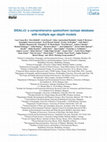Papers by Maria Bustamante

Characterizing the temporal uncertainty in palaeoclimate records is crucial for analysing past cl... more Characterizing the temporal uncertainty in palaeoclimate records is crucial for analysing past climate change, correlating climate events between records, assessing climate periodicities, identifying potential triggers and evaluating climate model simulations. The first global compilation of speleothem isotope records by the SISAL (Speleothem Isotope Synthesis and Analysis) working group showed that age model uncertainties are not systematically reported in the published literature, and these are only available for a limited number of records (ca. 15 %, n = 107/691). To improve the usefulness of the SISAL database, we have (i) improved the database's spatio-temporal coverage and (ii) created new chronologies using seven different approaches for agedepth modelling. We have applied these alternative chronologies to the records from the first version of the SISAL database (SISALv1) and to new records compiled since the release of SISALv1. This paper documents the necessary changes in the structure of the SISAL database to accommodate the inclusion of the new age models and their uncertainties as well as the expansion of the database to include new records and the qualitycontrol measures applied. This paper also documents the age-depth model approaches used to calculate the new chronologies. The updated version of the SISAL database (SISALv2) contains isotopic data from 691 speleothem records from 294 cave sites and new age-depth models, including age-depth temporal uncertainties for 512 speleothems.

Two well-dated d18O-speleothem records from Shatuca cave, situated on the northeastern flank of t... more Two well-dated d18O-speleothem records from Shatuca cave, situated on the northeastern flank of the
Peruvian Andes (1960 m asl) were used to reconstruct high-resolution changes in precipitation during
the Holocene in the South American Summer Monsoon region (SASM). The records show that precipitation
increased gradually throughout the Holocene in parallel with the austral summer insolation trend
modulated by the precession cycle. Additionally the Shatuca speleothem record shows several hydroclimatic
changes on both longer- and shorter-term time scales, some of which have not been described in
previous paleoclimatic reconstructions from the Andean region. Such climate episodes, marked by
negative excursions in the Shatuca d18O record were logged at 9.7e9.5, 9.2, 8.4, 8.1, 5.0, 4.1, 3.5, 3.0, 2.5,
2.1 and 1.5 ka b2k, and related to abrupt multi-decadal events in the SASM. Some of these events were
likely associated with changes in sea surface temperatures (SST) during Bond events in the North Atlantic
region. On longer time scales, the low d18O values reported between 5.1-5.0, 3.5e3.0 and 1.5 ka b2k were
contemporaneous with periods of increased sediment influx at Lake Pallcacocha in the Andes of Ecuador,
suggesting that the late Holocene intensification of the monsoon recorded at Shatuca site may also have
affected high altitudes of the equatorial Andes further north. Numerous episodes of low SASM intensity
(dry events) were recorded by the Shatuca record during the Holocene, in particular at 10.2, 9.8, 9.3, 6.5,
5.1, 4.9, 2.5 and 2.3 ka b2k, some of them were synchronous with dry periods in previous Andean records.








Uploads
Papers by Maria Bustamante
Peruvian Andes (1960 m asl) were used to reconstruct high-resolution changes in precipitation during
the Holocene in the South American Summer Monsoon region (SASM). The records show that precipitation
increased gradually throughout the Holocene in parallel with the austral summer insolation trend
modulated by the precession cycle. Additionally the Shatuca speleothem record shows several hydroclimatic
changes on both longer- and shorter-term time scales, some of which have not been described in
previous paleoclimatic reconstructions from the Andean region. Such climate episodes, marked by
negative excursions in the Shatuca d18O record were logged at 9.7e9.5, 9.2, 8.4, 8.1, 5.0, 4.1, 3.5, 3.0, 2.5,
2.1 and 1.5 ka b2k, and related to abrupt multi-decadal events in the SASM. Some of these events were
likely associated with changes in sea surface temperatures (SST) during Bond events in the North Atlantic
region. On longer time scales, the low d18O values reported between 5.1-5.0, 3.5e3.0 and 1.5 ka b2k were
contemporaneous with periods of increased sediment influx at Lake Pallcacocha in the Andes of Ecuador,
suggesting that the late Holocene intensification of the monsoon recorded at Shatuca site may also have
affected high altitudes of the equatorial Andes further north. Numerous episodes of low SASM intensity
(dry events) were recorded by the Shatuca record during the Holocene, in particular at 10.2, 9.8, 9.3, 6.5,
5.1, 4.9, 2.5 and 2.3 ka b2k, some of them were synchronous with dry periods in previous Andean records.
Peruvian Andes (1960 m asl) were used to reconstruct high-resolution changes in precipitation during
the Holocene in the South American Summer Monsoon region (SASM). The records show that precipitation
increased gradually throughout the Holocene in parallel with the austral summer insolation trend
modulated by the precession cycle. Additionally the Shatuca speleothem record shows several hydroclimatic
changes on both longer- and shorter-term time scales, some of which have not been described in
previous paleoclimatic reconstructions from the Andean region. Such climate episodes, marked by
negative excursions in the Shatuca d18O record were logged at 9.7e9.5, 9.2, 8.4, 8.1, 5.0, 4.1, 3.5, 3.0, 2.5,
2.1 and 1.5 ka b2k, and related to abrupt multi-decadal events in the SASM. Some of these events were
likely associated with changes in sea surface temperatures (SST) during Bond events in the North Atlantic
region. On longer time scales, the low d18O values reported between 5.1-5.0, 3.5e3.0 and 1.5 ka b2k were
contemporaneous with periods of increased sediment influx at Lake Pallcacocha in the Andes of Ecuador,
suggesting that the late Holocene intensification of the monsoon recorded at Shatuca site may also have
affected high altitudes of the equatorial Andes further north. Numerous episodes of low SASM intensity
(dry events) were recorded by the Shatuca record during the Holocene, in particular at 10.2, 9.8, 9.3, 6.5,
5.1, 4.9, 2.5 and 2.3 ka b2k, some of them were synchronous with dry periods in previous Andean records.